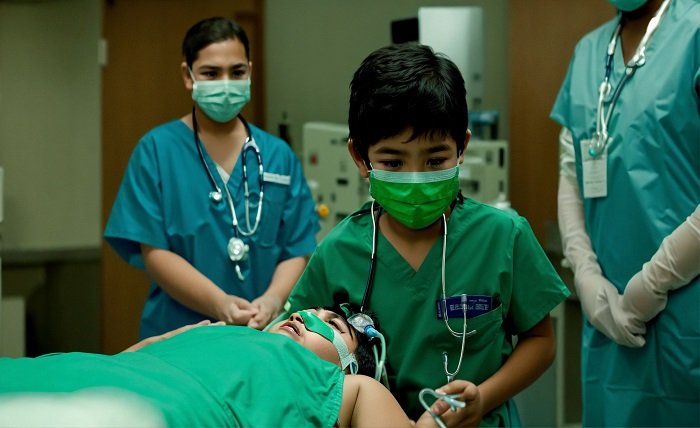In emergency scenarios, prompt and efficient assistance can make all the difference between life and death, particularly when it comes to children. A key idea that describes the necessary actions to guarantee that kids get the best care possible in an emergency is the pediatric out-of-hospital chain of survival. The elements of this chain, its importance, and doable actions that may be performed to improve outcomes for pediatric patients will all be covered in this handbook.
What is the Hospital Chain of Survival for Pediatric Out-of-Hospital Patients?
The pediatric out-of-hospital chain of survival is a set of vital steps that, when taken quickly, can dramatically increase a child’s chances of surviving a medical emergency. Since children are not simply miniature versions of adults, this chain is designed to meet their specific physiological and developmental demands.
Important Elements of the Pediatric Hospital chain of survival: Prevention
1. Avoidance
2. Early Cardiac Arrest Identification and Quick, High-Quality CPR
3. Quick Emergency Services Activation
4. Advanced Medical Attention and Transportation
5.Care Following Cardiac Arrest
Healthcare providers, parents, and caregivers must comprehend each of these elements.
Prevention Is Your Best Defense
Recognizing the Significance of Prevention
Preventive measures are the initial link in the pediatric out-of-hospital chain of survival. This entails teaching families about typical dangers and preventative steps to lower the frequency of emergencies.
Safety Instruction
Home safety: measures include installing safety gates, childproofing the house, and putting hazardous materials out of reach.
Water safety: includes teaching kids to swim, employing flotation devices, and keeping an eye on them when they’re near water.
Car Safety: making certain that the proper seat belts and vehicle seats are being used.
The probability of emergencies happening can be decreased by taking proactive measures to address possible threats.
Early Identification of Heart Arrest
Knowing the Indications
It’s critical to identify discomfort in children in order to start the cycle of hospital chain of survival. The following symptoms should be recognized by parents and other caregivers:
Unresponsiveness: The youngster is unresponsive to yelling or shaking.
Breathing Problems: Gasping, erratic breathing, or shortness of breath are symptoms.
Pale or Blue Skin: A shift in tone may be a sign of low oxygen levels.
The Value of Education
Frequent training for community members, parents, and caregivers can enhance early detection. Children-specific programs like CPR and First Aid classes can provide people with the skills they need to act quickly in an emergency.
Quick, High-Grade CPR
Giving Children CPR

It’s critical to start CPR right away if a youngster is unconscious and not breathing. An excellent CPR consists of:
Compressions to the Chest: Depending on the child’s size, use one or two hands. For babies, compressions should be placed 1.5 to 2 inches deep, and for children, 2 inches deep.
Breaths of Rescue: After every 30 compressions, administer two rescue breaths to children. Breathe in until the child’s chest rises, making sure their airway is open.
The Value of Appropriate Methodology
It’s essential to get training in pediatric CPR procedures. Particular courses that highlight the distinctions between adult and kid CPR are offered by the American Heart Association and other organizations.
Advanced Care and Transport
Making the Switch to Emergency Services
EMS will evaluate the child’s condition and administer any necessary treatment as soon as they arrive. This may consist of:
Advanced Control of Airways: putting in an airway device to guarantee the delivery of oxygen.
Drugs: giving medicine for diseases such as irregular heart rhythms.
Transportation to the Medical Facility
It’s critical to transfer patients quickly to a facility that can handle pediatric crises. Having knowledge about the pediatric speciality hospitals in the area might aid caregivers in making well-informed judgments during crises.
Conclusion, Education and Training Can Empower Communities
A structure called the pediatric out-of-hospital chain of survival is intended to direct actions in dire circumstances involving children. Every link in this chain is essential to ensuring that pediatric patients have the greatest potential outcomes. We can make our children’s environments safer and give communities the tools they need to respond to emergencies by emphasizing prevention, early recognition, immediate CPR, quick EMS activation, advanced care, and post-cardiac arrest support.
Hospital Chain of Survival, FAQ
What is the pediatric chain of hospital chain of survival initial step?
Preventive efforts, such as teaching families about safe practices to lower hazards, are the initial stage.
How can I become certified in child CPR?
There are numerous organizations that offer CPR and First Aid classes expressly for pediatric situations, such as the American Heart Association.
What indicators can I look out for to determine whether a youngster need CPR?
Take note of any breathing difficulties, lack of response, or changes in skin tone (blue or pale).
When ought I to contact the emergency services?
If you see any life-threatening symptoms in a kid, or if they are unconscious and not breathing, call emergency services right away.
While I wait for emergency services to arrive, what should I do?
Up until emergency personnel arrive or the youngster starts breathing on their own, keep performing excellent CPR.
What function does care after a cardiac arrest serve?
In order to minimize brain damage and guarantee that the child receives the proper medical attention following resuscitation, post-cardiac arrest care is crucial.







